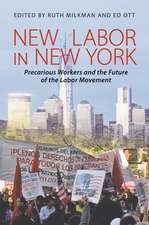Coercion, Survival, and War: Why Weak States Resist the United States
Autor Phil Haunen Limba Engleză Hardback – 30 iun 2015
In practice, however, the coercive strategies of the U.S. have frequently failed. In Coercion, Survival and War Phil Haun chronicles 30 asymmetric interstate crises involving the US from 1918 to 2003. The U.S. chose coercive strategies in 23 of these cases, but coercion failed half of the time: most often because the more powerful U.S. made demands that threatened the very survival of the weak state, causing it to resist as long as it had the means to do so. It is an unfortunate paradox Haun notes that, where the U.S. may prefer brute force to coercion, these power asymmetries may well lead it to first attempt coercive strategies that are expected to fail in order to justify the war it desires.
He concludes that, when coercion is preferred to brute force there are clear limits as to what can be demanded. In such cases, he suggests, U.S. policymakers can improve the chances of success by matching appropriate threats to demands, by including other great powers in the coercive process, and by reducing a weak state leader's reputational costs by giving him or her face-saving options.
Preț: 266.52 lei
Nou
50.100€ • 53.25$ • 42.11£
Carte tipărită la comandă
Livrare economică 15-29 aprilie
Specificații
ISBN-10: 0804792836
Pagini: 288
Dimensiuni: 152 x 229 x 20 mm
Greutate: 0.5 kg
Editura: Stanford University Press
Colecția Stanford Security Studies
Recenzii
Notă biografică
Cuprins
This chapter introduces the question of why the United States so often fails to coerce weak states. Coercion is defined as the threat of force or restricted use of force to convince a target to comply with a challenger's demands. In asymmetric interstate conflict a powerful challenger chooses between accommodation, brute force or coercion. The chapter includes a table and summary statistics for the thirty asymmetric crises between the United States and weak states since World War II. The chapter considers conventional non-rational and rational explanations for coercion failure and introduces an alternative explanation based on a weak state's survival concerns. The chapter concludes by reflecting on why the United States would knowingly make coercive demands that threaten survival and offers an explanation based on the desire to lower the diplomatic and political costs of going to war.
This chapter develops a theory of asymmetric interstate coercion. A coercive strategy includes compellent or deterrent demands, punishment or denial threats, and costly signals. The determinants of coercion success are measured, coercive diplomacy is considered where the use of force is only threatened, and the relationship between economic sanctions and coercion is discussed. A model of asymmetric coercion is developed where demands, threats and costly signals are determined by the powerful challenger and in response the weak target chooses whether to resist or concede. In equilibrium, a coercive strategy should only be adopted when the target is expected to concede. The coercion range depicts the set of successful coercive demands for which the challenger prefers coercion to accommodation or brute force and the target prefers concession to resistance. The chapter concludes by discussing rational and non-rational explanations for why coercion might still fail.
This chapter considers why powerful states issue high level demands of weak states. Given a high probability of victory a powerful challenger must expect high level concessions to prefer coercion to brute force. When demands threaten the sovereignty of the weak state, however, it is likely to resist. The unitary actor assumption for the weak state is relaxed to also consider the survival concerns of its regime and regime leadership. Rationally, a powerful challenger should not coerce when demands threaten a target's survival. However, when the costs of coercion are low and when there is uncertainty whether the target will concede then it may make sense to coerce while preparing for war. Also, if the external costs for adopting a brute force strategy are high, then first having the United Nations Security Council issue coercive resolutions may decrease the diplomatic and political costs for later going to war.
This chapter considers two crises between the United States and Iraq. In the 1991 Gulf War and the 2003 Iraq War, the United States adopted coercive strategies which threatened the survival of Saddam's regime and the Iraqi state. These crises test the limits for what coercion can achieve and examine the tradeoffs between coercive and brute force strategies. In both crises, U.S. administrations chose coercive strategies they did not intend to have succeed in order to then implement the brute force strategies they preferred. These two crises thus provides insight into the key questions addressed by this book as to why the United States so often chooses coercion, why coercion so often fails as weak states resist, and, knowing this, why the U.S decision makers still prefer coercive strategies.
This chapter examines two crises of the US against the Bosnian Serbs and Serbia in 1992 and 1999, respectively. In both cases, coercive diplomacy failed but coercion ultimately succeeded. The first crisis arose over actions in the Bosnian Civil War from 1992 to 1995, whereby the United States finally coerced the Bosnian Serbs into accepting a peace agreement but could never compel them to give up territory until it had already been taken by force. The second crisis arose over Serbia's treatment of Kosovar Albanians and concluded when Serbia's President Slobodan Milosevic finally conceded Kosovo after a 78-day NATO air campaign. He conceded, however, only when the expected economic costs to Serbia from the air campaign outweighed the political value of maintaining control of Kosovo. This crisis is a rigorous test of the survival hypothesis as Serbia eventually conceded homeland territory while it still retained the means to resist.
This chapter considers three cases between the United States and Libya from 1981 until 2003. Libya's support of international terrorism triggered a crisis for the United States, culminating in the El Dorado Canyon air raid in April 1986. Coercion ultimately failed because of the mismatch between demands and threats as an isolated Reagan administration could not maintain the credible threat of force. The second case commenced with the bombing of Pan Am Flight 103 over Lockerbie, Scotland in December 1988. It concluded with the extradition of two Libyan officials in 1999 to stand trial at The Hague. Another crisis commenced in September of 2002 when British Prime Minister Tony Blair, with the backing of George W. Bush, made overtures to Muammar Qaddafi to resume negotiations over Libya's WMD. The case concluded in December 2003 when Qaddafi abandoned Libya's nuclear, biological and chemical ambitions.
This chapter summarizes the book's main argument that the United States, because of its power advantage, has an incentive to make large coercive demands of weak states that if conceded threaten the survival of the state, the regime or its leadership. Due to international norms to first seek negotiated settlements prior to war, the U.S. has an incentive to go to the UN and adopt a coercive strategy the U.S. does not believe will, or does not want to succeed, to obtain justification and support for a brute force war. Alternative explanations based on non-rational behavior, uncertainty, and commitment problems help to explain why crises arise and why coercive diplomacy fails, but does not provide insight into when coercion is likely to succeed or fail. The book concludes with implications for U.S. foreign policy.















